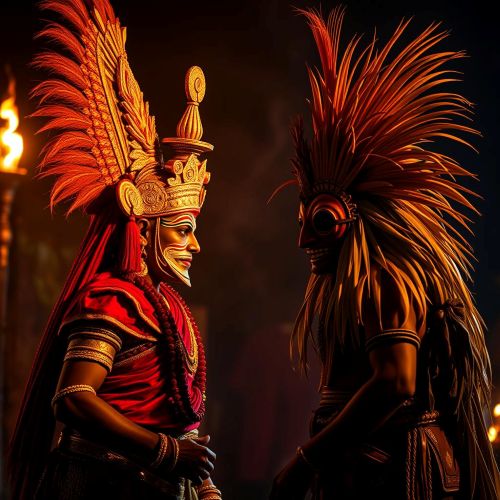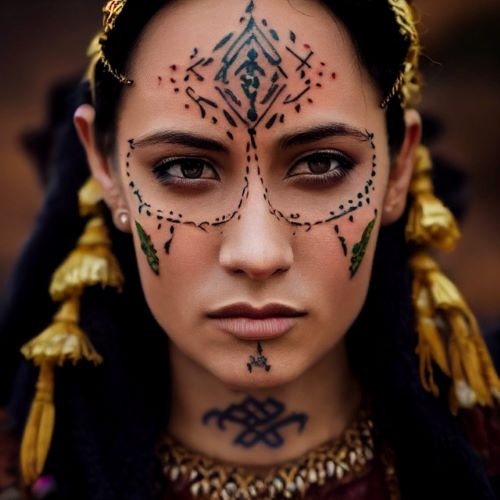Panjurli vs Guliga: The Myth Behind Kantara Chapter 1
The 2022 Kannada film Kantara introduced the wider world to the mystical traditions of Bhuta Kola, a spiritual practice rooted in the Tulu Nadu region of coastal Karnataka. In its newly released prequel, Kantara: Chapter 1, the spotlight shifts to the origin story of the divine entities Panjurli and Guliga. These two daivas, or spirits, are central figures in the region’s mythology, and their presence in the film underscores the deep cultural connection between cinema and folklore. The confrontation between Panjurli and Guliga is more than just a tale of supernatural rivalry—it is a reflection of balance, justice, and the struggles between benevolent and ferocious energies.
Panjurli – The Boar Spirit of Protection
Panjurli is one of the most beloved daivas in the Bhuta Kola tradition. Associated with the wild boar, Panjurli symbolizes fertility, protection, and justice. Mythology describes Panjurli as a cursed form of a divine boar who descended to Earth to protect the faithful. Revered as a guardian spirit, Panjurli is considered compassionate yet powerful, ensuring prosperity and punishing dishonesty.
In Kantara: Chapter 1, Panjurli’s role is depicted as a protector of the people and the forests. His presence is tied to land and lineage, reinforcing the sacred bond between nature and human communities. The rituals shown in the movie emphasize how villagers surrender themselves to Panjurli’s authority during Bhuta Kola ceremonies, treating him as both judge and guardian.
Guliga – The Fierce Daiva of Wrath
In contrast, Guliga represents a darker, more ferocious force within the Bhuta pantheon. Unlike Panjurli’s forgiving nature, Guliga is a spirit of rage, destruction, and cosmic balance. Traditionally, Guliga is portrayed as uncompromising, a daiva who enforces justice through fear and punishment rather than mercy.
The film portrays Guliga as a counterpart to Panjurli—neither entirely evil nor benevolent, but embodying the fierce energies that counterbalance Panjurli’s gentleness. In Tulu tradition, Guliga’s rituals are often more intense, featuring fiery performances, loud chants, and symbolic acts of submission, all meant to channel his wrathful power while maintaining harmony in society.
The Story of Panjurli and Guliga in Kantara Chapter 1
The central myth explored in Kantara: Chapter 1 revolves around the tension between Panjurli and Guliga. According to folklore, Panjurli was sent to Earth to protect villages, crops, and sacred groves. However, the cosmic order required balance. Guliga, fierce and untamed, was placed alongside Panjurli to ensure that protection did not turn into unchecked power.
In the movie, this dynamic is dramatized as a confrontation between the two daivas. Panjurli embodies justice, fertility, and prosperity, while Guliga represents rage, punishment, and control over destructive energies. Their clash is not one of good versus evil, but of opposing forces meant to keep the world in equilibrium.
The film captures this tension through grand ritualistic sequences. Panjurli’s arrival is shown as graceful and divine, while Guliga’s entry is thunderous and fiery. The narrative builds on the idea that both spirits must coexist, even in conflict, to maintain harmony in human lives and in the natural world.
Symbolism in the Conflict
The story of Panjurli and Guliga resonates deeply with Tulu cultural philosophy. It illustrates the ancient belief that creation and destruction are inseparable. Panjurli stands for nurturing and protection, but without Guliga’s ferocity, justice might become lenient or misused. Together, they form a cosmic duality—light and shadow, mercy and wrath, fertility and decay.
For the audience, this duality reflects human struggles as well. Communities often seek the compassion of Panjurli but fear the wrath of Guliga, reminding them to live with honesty, humility, and respect for nature. Kantara: Chapter 1 uses this myth to comment on the need for balance in society, where order must be preserved not only through love but also through discipline.
Panjurli and Guliga in Bhuta Kola Rituals
Outside cinema, Panjurli and Guliga are integral to Bhuta Kola rituals performed across Tulu Nadu. These annual ceremonies involve elaborate dances, vibrant costumes, music, and offerings. Performers channel the spirits, believed to be possessed by the daivas, and deliver messages of justice to the community.
When Panjurli is invoked, villagers pray for prosperity, agricultural success, and resolution of disputes. Guliga, on the other hand, is invoked with fear and reverence, as his blessings come with strict conditions. The rituals often stage a dramatic interplay between the two daivas, symbolizing their eternal coexistence. This lived tradition enriches the authenticity of Kantara: Chapter 1 and connects modern viewers to centuries-old cultural practices.
Impact of Kantara: Chapter 1 on Popular Culture
By highlighting the myth of Panjurli and Guliga, Kantara: Chapter 1 has done more than just entertain—it has brought Bhuta Kola into mainstream cultural conversation. Audiences across India and abroad are now curious about these unique rituals and the spiritual philosophy behind them. The film serves as a bridge, making regional folklore accessible while retaining its sacred essence.
This cinematic depiction also inspires pride among Tulu communities, who see their traditions represented on the big screen. For viewers unfamiliar with Bhuta Kola, the story of Panjurli and Guliga becomes a doorway to understanding the region’s deep respect for spirits, ancestors, and nature.
Conclusion
The tale of Panjurli and Guliga, as told in Kantara: Chapter 1, is not just a story of two spirits locked in conflict. It is a symbolic narrative about balance, justice, and the coexistence of opposing forces. Panjurli’s compassion and Guliga’s ferocity together maintain the cosmic order, teaching generations the value of harmony and respect for nature.
By weaving this folklore into cinema, Kantara has immortalized one of the most profound myths of Tulu Nadu. It reminds us that mythology is not a relic of the past but a living tradition that continues to shape cultural identity and modern storytelling.
No posts were found.









